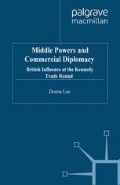Abstract
Richard Rosencrance has stated that ‘history is a laboratory in which our generalizations about international politics can be tested.’1 This chapter discusses the generalizations about middle power influence in international politics in three contending perspectives: classical realism, hegemonic stability theory and middle power approaches. Classical realism sees middle power influence in balances of power in multilateral structures. Hegemonic stability theory anticipates significant middle power influence in hegemonic structures, and especially during periods of hegemonic decline. Middle power approaches expect middle power influence in multilateral structures.
Access this chapter
Tax calculation will be finalised at checkout
Purchases are for personal use only
Preview
Unable to display preview. Download preview PDF.
Notes
M. Wight, Power Politics, H. Bull and C. Holbraad (eds) (Leicester: Leicester University Press, 1978 ), p. 65.
G. Berridge, International Politics: States, Power & Conflict since 1945, 3rd edn ( Hemel Hempstead: Prentice Hall/Harvester Wheatsheaf, 1997 ) p. 17.
B. Hocking and M. Smith, World Politics: An Introduction to International Relations, 2nd edn ( London: Prentice Hall/Harvester Wheatsheaf, 1995 ), p. 198.
T. Risse-Kappen, Cooperation Among Allies: European Influence on US Foreign Policy ( Princeton, NJ: Princeton University Press, 1995 ), p. 21.
J. W. Holmes, Canada the Middle Aged Power ( Toronto: McClelland & Stewart, 1976 ).
F. Costigliola, ‘The failed design: Kennedy, de Gaulle, and the struggle for Europe’, Diplomatic History, 8 (1984) 227–51.
S. Guzzini, Realism in International Relations and International Political Economy ( London: Routledge, 1998 ), p. 156.
K. Dam, The Gatt: Law and International Economic Organization ( Chicago: Chicago University Press, 1970 ) p. 10.
L. Neack, J. A. K. Hey and P. J. Honey (eds), Foreign Policy Analysis: Continuity and Change in its Second Generation ( Englewood Cliffs, NJ: Prentice Hall, 1995 ), p. 225.
F. O. Hampson, ‘Climate change: building coalitions of the like minded’, International Journal, 45 (1990) 36–74.
R. W. Cox, Production, Power, and World Order: Social Forces in the Making of History ( New York: Columbia University Press, 1987 ).
A. B. Fox, The Politics of Attraction: Four Middle Powers and the United States (New York: Columbia University Press, 1977 ).
Author information
Authors and Affiliations
Copyright information
© 1999 Donna Lee
About this chapter
Cite this chapter
Lee, D. (1999). Middle Power Influence in the International System. In: Middle Powers and Commercial Diplomacy. Studies in Diplomacy. Palgrave Macmillan, London. https://doi.org/10.1057/9780333984352_2
Download citation
DOI: https://doi.org/10.1057/9780333984352_2
Publisher Name: Palgrave Macmillan, London
Print ISBN: 978-1-349-40948-8
Online ISBN: 978-0-333-98435-2
eBook Packages: Palgrave Political & Intern. Studies CollectionPolitical Science and International Studies (R0)

